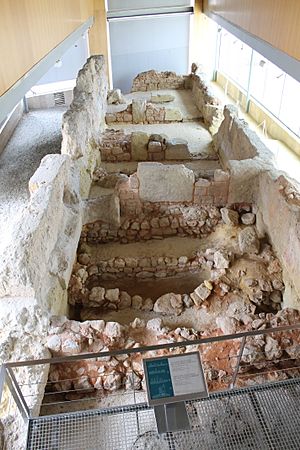Punic wall of Cartagena facts for kids
The Punic wall of Cartagena is an ancient site from the 3rd century BC. Here, you can see parts of the very first defensive wall of Cartagena. It was built by the Carthaginians, a powerful group from North Africa.
This wall is super important because it's one of the few things left from the Carthaginian civilization in Spain. The walls also tell a story about a huge event in Ancient history: the Second Punic War. This war changed a lot of things around the Mediterranean Sea.
History of the Wall
In 227 BC, a Carthaginian general named Hasdrubal the Fair started a new city. He called it Qart Hadasht. It was probably built on an older settlement used by the Iberians, who were people already living in Spain.
The new city was in a great spot for defense. It sat on a peninsula (land almost surrounded by water) inside a bay. It also had five tall hills, with two right at the entrance to the city. This made it very hard for enemies to attack.
Because of this, the Carthaginians decided to build a strong wall around their new capital in Spain. This happened between 227 BC and 209 BC. The wall was key to protecting the city. For example, it helped stop a Roman attack in 216 BC during the Second Punic War. Roman generals Gnaeus and Publius Cornelius Scipio led this attack.
However, the walls couldn't hold out forever. When the famous Roman general Scipio Africanus arrived, he attacked the city by land and sea. The Romans had more soldiers. They found a way around the defenders on the walls and took Qart Hadasht after a tough fight. This battle marked the beginning of the end for Carthaginian power in southern Spain.
How the Wall Was Built
The Punic wall was built using ideas from Hellenistic architecture. It has two parallel layers of stone, called paramento. These layers are made of tabaire, a type of sandstone found in local quarries. Parts of the wall still stand about three meters (nearly 10 feet) high today.
The parts of the Punic wall you can see now are from the section that guarded the entrance to the city. This part was between two hills, San José and Monte Sacro. In ancient times, these hills were called Aletes and Baal. During archaeological digs, experts found signs of a fire. This fire might have happened during the battle or the looting that followed when the Romans took the city.
Today, you can visit the wall at the Interpretation Center of the Punic Wall. This center is part of Cartagena Puerto de Culturas, a group that promotes tourism. The building protects the ancient site and shows what the wall might have looked like when it was new.
See also
 In Spanish: Muralla púnica de Cartagena para niños
In Spanish: Muralla púnica de Cartagena para niños


